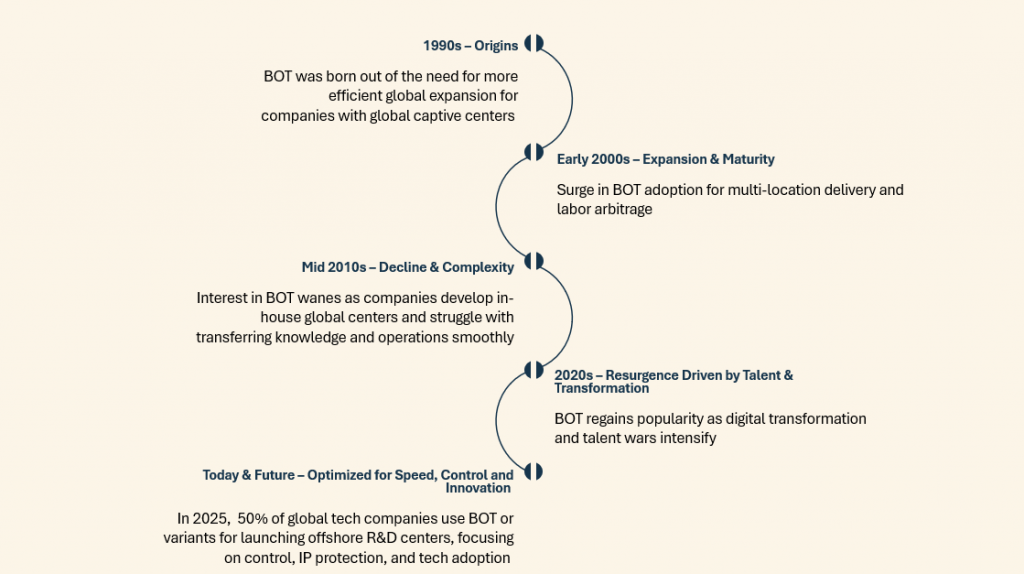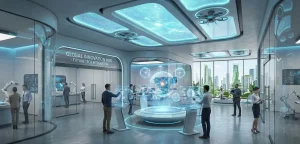How BOT Models Are Evolving for IT, Business Process, and R&D Services
With increasing demand for efficient services, more diverse and innovative technological models are emerging to support business processes. One such technological development is the rise of the build-operate-transfer (BOT) models in IT, business process, and R&D services.
This strategic framework enables businesses to leverage external expertise, mitigate risks, and attain operational excellence. It also ensures the smooth transfer of knowledge and skills.
Evolution of BOT Models in IT and Business Process Outsourcing
The BOT model is reshaping outsourcing by offering a strategic alternative to traditional methods where companies can create custom operational units. This model provides greater control and fosters innovation. Its evolution shows a clear shift towards strategic partnerships, moving from simple tasks to core business functions.
Here’s how it is being leveraged:
BOT for IT Services
The BOT model first gained traction in IT services. It helped companies build dedicated offshore development centers and offered immense flexibility and control. Businesses could create solutions tailored to their unique needs.
The setup partner established and managed the IT infrastructure end-to-end, overseeing everything from talent acquisition to project delivery. After a defined period, the entire operation was seamlessly transferred to the client—complete with a fully functional, experienced IT team. This model enabled the enterprise to scale its technology capabilities rapidly, efficiently, and with minimal risk.
BOT for Business Processes
Soon, the model found a new, effective application in Business Process Outsourcing (BPO). Companies began using BOT for various essential functions, including customer service, human resources, and financial operations.
It allowed them to design bespoke business processes from the ground up that perfectly aligned with their specific corporate goals. The setup partner managed the initial, often complex, setup phase. The client could then integrate a proven, efficient operational unit. This method drove significant and lasting improvements.
BOT for R&D Services
The most recent evolution of this model is in Research & Development services. The BOT model is now used to create specialized innovation hubs, which represent a major strategic leap forward. Companies can establish dedicated R&D centers in global talent hotspots, which leverage a partner’s local expertise to build these facilities.
These centers focus on creating new products and proprietary technologies. After the transfer, the company owns a valuable R&D asset. This model helps embed innovation deep within an organization. Using this model in R&D services ensures a continuous flow of new, market-leading ideas.

Benefits and Challenges of Modern BOT Models
As the BOT model promises to streamline complex operations, its adoption is accelerating across sectors. However, this technology presents a complex picture with powerful benefits alongside significant challenges. Understanding this duality is crucial for successful implementation.
Benefits
- Enhanced Efficiency: BOTs handle routine tasks with ease. This frees teams for strategic work.
- Improved Accuracy: Automation reduces the potential for human error. This leads to more precise outcomes.
- Cost Reduction: Over time, BOTs can lower operational expenses significantly.
Challenges
- High Initial Cost: Implementing advanced BOTs requires a notable upfront investment.
- Integration Complexity: Merging these models with existing legacy systems can be difficult.
- Data Security Risks: Automated systems can introduce new security vulnerabilities.
By balancing operational control with innovation, BOT models offer strategic advantages alongside challenges. Embracing this approach can unlock efficiency, accuracy, and cost benefits while fostering growth.
To navigate the complexities with ease and maximize the success of the BOT model, connect with ANSR to leverage our expertise in building, operating, and seamlessly transferring Global Capability Centers to enhance business functions.




